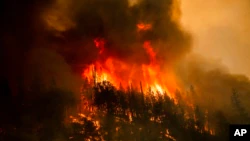Wildfires in California and Montana exploded in size overnight amid windy, hot conditions and were quickly encroaching on neighborhoods, forcing evacuation orders for more than 100 homes Saturday, while an Idaho blaze was spreading.
In California’s Klamath National Forest, the fast-moving McKinney fire, which started Friday, went from charring just more than 1 square kilometer to scorching as much as 160 square kilometers by Saturday in a largely rural area near the Oregon state line, according to fire officials.
“It’s continuing to grow with erratic winds and thunderstorms in the area and we’re in triple digit temperatures,” said Caroline Quintanilla, a spokesperson at Klamath National Forest.
Meanwhile in Montana, the Elmo wildfire nearly tripled in size to about 28 square kilometers within a few kilometers of the town of Elmo. Roughly 320 kilometers to the south, Idaho residents remained under evacuation orders as the Moose Fire in the Salmon-Challis National Forest charred more than 174.8 square kilometers in timbered land near the town of Salmon.
California fires
A significant buildup of vegetation was fueling the McKinney fire, said Tom Stokesberry, a spokesperson with the U.S. Forest Service for the region.
“It’s a very dangerous fire — the geography there is steep and rugged, and this particular area hasn’t burned in a while,” he said.
A small fire was also burning nearby, outside the town of Seiad, Stokesberry said. With lightning predicted over the next few days, resources from across California were being brought in to help fight the region’s fires, he said.
McKinney’s explosive growth forced crews to shift from trying to control the perimeter of the blaze to trying to protect homes and critical infrastructure like water tanks and power lines and assist in evacuations in California’s northernmost county of Siskiyou.
Deputies and law enforcement were knocking on doors in the county seat of Yreka and the town of Fort Jones to urge residents to get out and safely evacuate their livestock onto trailers. Automated calls were being sent to land phone lines as well because there were areas without cellphone service.
More than 100 homes were ordered to be evacuated and authorities were warning people to be on high alert. Smoke from the fire caused the closure of portions of Highway 96.
“We’re asking residents all over the area to be ready,” Siskiyou County Sheriff’s Office spokesperson Courtney Kreider said. “Last night we were pushing out evacuations about every hour, and there are large portions of the county that are in warning areas.”
Meanwhile, crews made significant progress in battling another major blaze in California that forced evacuations of thousands of people near Yosemite National Park earlier this month. The Oak fire was 52% contained by Saturday, according to a Cal Fire incident update.
Southern Oregon
The Pacific Coast Trail Association urged hikers to get to the nearest town while the U.S. Forest Service closed a 177-kilometer section of the trail from the Etna Summit to the Mount Ashland Campground in southern Oregon.
Oregon state Rep. Dacia Grayber, who is a firefighter, was camping with her husband, who is also in the fire service, near the California state line when gale-force winds awoke them just after midnight.
The sky was glowing with strikes of lightning in the clouds, and ash was blowing at them, though they were in Oregon about 16 kilometers from the fire, Grayber said.
“These were some of the worst winds I’ve ever been in, and we’re used to big fires,” she said. “We got the heck out of there.”
On their way out, they came across hikers on the Pacific Coast Trail fleeing to safety, she said.
“The terrifying part for us was the wind velocity,” she said. “It went from a fairly cool breezy night to hot, dry hurricane-force winds. Usually that happens with a fire during the day but not at night. I hope for everyone’s sake this dies down but it’s looking like it’s going to get worse.”
Montana and Idaho
In western Montana, the wind-driven Elmo fire forced evacuations of homes and livestock as it raced across grass and timber, according to The National Interagency Fire Center, based in Idaho. The agency estimated it would take nearly a month to contain the blaze.
A portion of Highway 28 between Hot Springs and Elmo was closed because of the thick smoke, according to the Montana Department of Transportation.
Crews from several different agencies were fighting the fire on Saturday, including the Confederated Salish and Kootenai Tribes Fire Division. Six helicopters were making drops on the fire, aided by 22 engines on the ground.
In Idaho, more than 930 wildland firefighters and support staff were battling the Moose fire Saturday and protecting homes, energy infrastructure and the Highway 93 corridor, a major north-south route.
A red flag warning indicated that the weather could make things worse with the forecast calling for “dry thunderstorms,” with lightning, wind and no rain.
Wildfire legislation
As fires raged across the West, the U.S. House on Friday approved wide-ranging legislation aimed at helping communities in the region cope with increasingly severe wildfires and drought — fueled by climate change — that have caused billions of dollars in damage to homes and businesses in recent years.
The legislative measure approved by federal lawmakers Friday combines 49 separate bills and would increase firefighter pay and benefits; boost resiliency and mitigation projects for communities affected by climate change; protect watersheds; and make it easier for wildfire victims to get federal assistance.
The bill now goes to the Senate, where California Democratic Sen. Dianne Feinstein has sponsored a similar measure.


